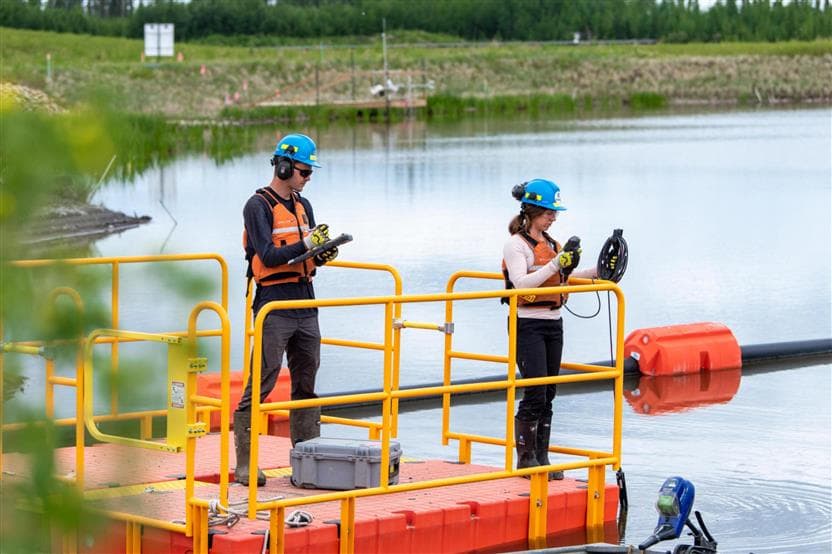All forms of mining – whether coal, gold, uranium or potash – produce tailings. Oil sands tailings are the sand, water, clay, silt and residual bitumen that remain after most of the oil is extracted from mined ore. Tailings are stored in tailings ponds with engineered dams on our oil sands sites.
Although sand separates quickly from the tailings, smaller particles of clay and silt remain suspended in water and form fluid tailings, which in the past could take decades to separate. Finding ways to dewater fluid tailings more quickly for release back to the natural environment is critical to improving overall reclamation planning and performance.
We are currently treating more fluid tailings than we produce at our Base Plant site through our holistic tailings management approach and permanent aquatic storage structure (PASS) treatment process. We are also progressing several tailings facilities to closure and will be increasing treatment capacity in the next few years.
Treating and reclaiming tailings
Our tailings technology improvements focus on fluid tailings treatment.
More than 90% of tailings form coarse tailings deposits. We use the coarse tailings to backfill the mine and build structures like tailings dams. These coarse tailings require no treatment before reclamation. Fluid tailings make up less than 10% of tailings and are treated and used for future reclamation into closure landscapes. Treating fluid tailings quickly and cost-effectively, as well as safely releasing water from our sites, is critical to improving our overall reclamation performance.
As our mining operations have expanded, the volume of fluid tailings stored on site has increased. However, with Base Plant’s implementation of tailings technologies such as the PASS fluid treatment process, we’re reducing untreated fluid tailings inventory and treating more than we produce. We are applying what we’ve learned from the PASS treatment process at Base Plant to our Fort Hills operations. Treatment technologies developed by Syncrude are also being shared across our sites.
Tailings management regulations
We follow the Tailings Management Framework (TMF) that was developed by Alberta Environment and Parks under the Lower Athabasca Regional Plan. The Alberta Energy Regulator also implemented Directive 085: Fluid Tailings Management for Oil Sands Mining Projects, a key part of TMF implementation, to minimize fluid tailings inventories through progressive fluid tailings treatment during the life of a project.
Dam safety and integrity
We take tailings dam safety very seriously, and our tailings ponds are designed with measures in place to protect the surrounding environment. Our tailings facilities are carefully operated and monitored (during and after construction) as part of a disciplined dam safety management system. Our monitoring systems observe dam integrity and manage water over the lifecycle of tailings ponds.
We follow Canada’s stringent regulations governing tailings and dam safety. This includes Alberta Environment and Parks’ Dam and Canal Safety Directive, requirements for industry-leading practices for dam safety management regulations, and the Mining Association of Canada’s (MAC) Toward Sustainable Mining Tailings Management Protocol, recognized as the benchmark for responsible tailings facility management. This protocol has been adopted by many mining jurisdictions around the world as best practice and we meet or exceed its requirements.
Community engagement and industry collaboration
We believe it’s important to work and engage with Indigenous communities and stakeholders to review our approach and share reclamation tailings progress and challenges. One way we do this is through our annual engagement sessions hosted for communities to offer feedback on our approach to tailings management. The feedback we receive is also used to help shape future engagement activities.
We continue to share our learnings with other operators through organizations like Canada’s Oil Sands Innovation Alliance (COSIA). Through knowledge sharing, we’re continuously improving tailings management.



.jpg?mw=304&modified=20230221213248&hash=A977B81C343C8F5A0E24741FDDB8BF9F)
.jpg?mw=304&modified=20220921171014&hash=8FD467694C312EAD1B1CBB6AE8AE9DCB)
